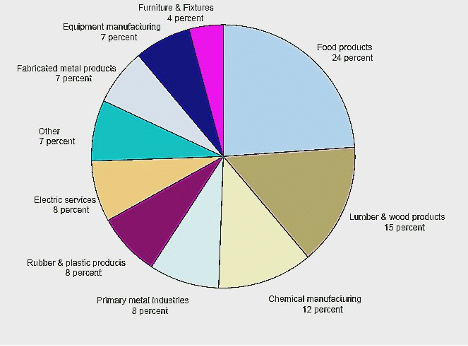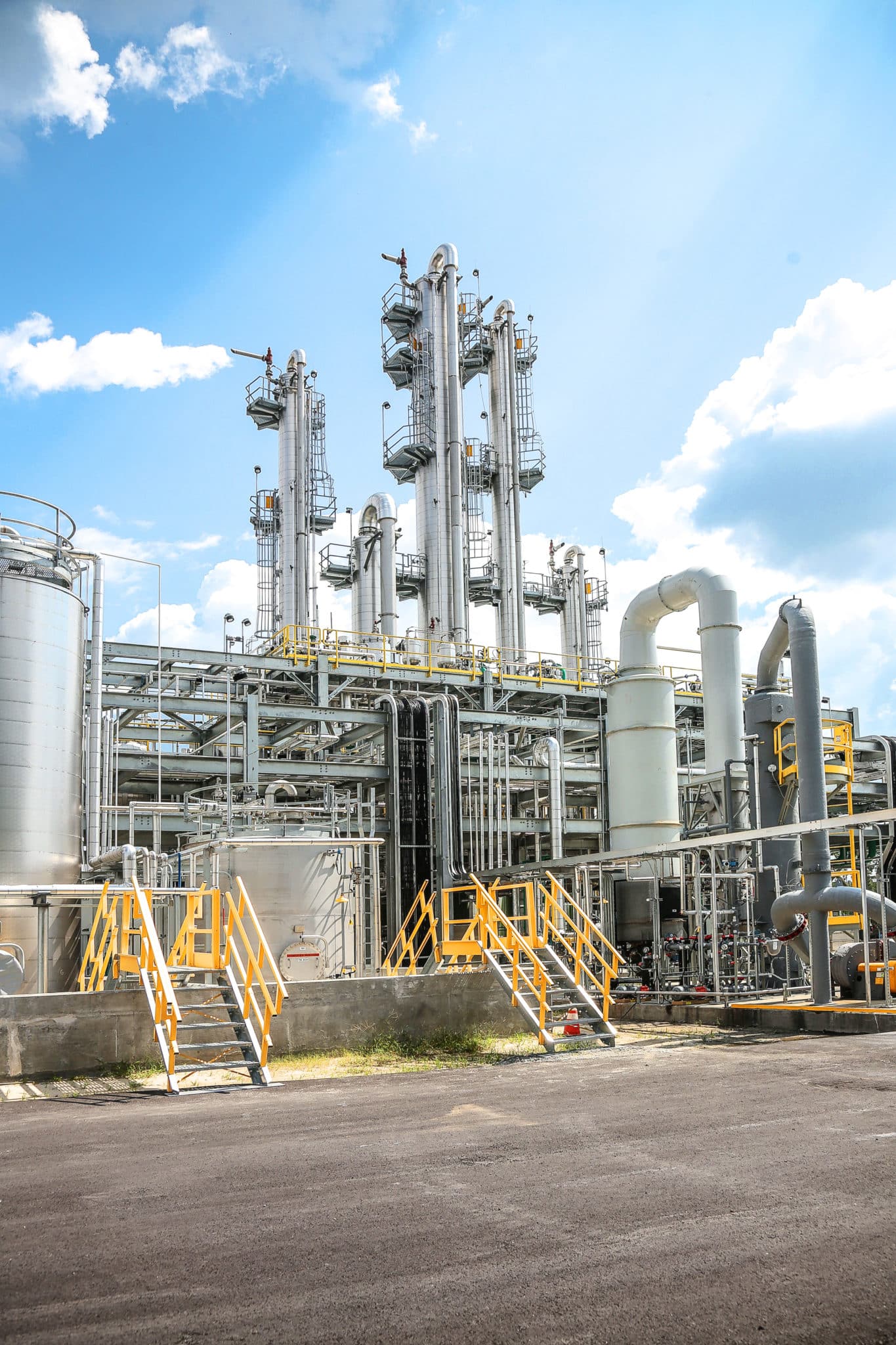Handling combustible dusts causes significant hazards for many industrial facilities. The hazards include flash fires and explosions that can rupture equipment, destroy buildings, injure workers, and cause loss of life. In fact, the CSB (Chemical Safety Board) reported 281 combustible dust incidents between 1980 and 2005 that killed 119 workers, injured 718, and extensively damaged industrial facilities.
These facilities included food processing, wood processing, chemical manufacturing metals processing, rubber & plastics processing, equipment manufacturing, and furniture production. Below is a chart of percent dust explosion incidents in different industries. In addition, CSB has investigated five incidents between 2006 and 2017 that have taken the lives of 27 workers, injured 61 others, and significantly damaged industrial facilities

Distribution of Combustible Dust Incidents by Industry (281 Incidents from 1980 to 2005)
NFPA (National Fire Protection Agency) defines combustible dust as: “A finely divided combustible particulate solid that presents a flash-fire hazard or explosion hazard when suspended in air or the process-specific oxidizing medium over a range of concentrations.” Traditionally, combustible dusts were defined as ≤ 420 µm. However, the current size criterion is ≤ 500 µm with particles capable of passing through a U.S. No. 35 standard sieve. In addition, certain flat particles, flakes, or fibers with higher surface to volume ratios could be explosible. Regardless of the definitions, combustibility data must be obtained for all dusts being handled in industrial facilities. In many cases, data is available to determine if a particular dust is combustible or not. If data is not available, the dust must be tested per NFPA requirements to determine combustibility.
Handling combustible dusts causes unique hazards. Typical combustion requires three elements: fuel, oxygen, and an ignition source. A dust explosion requires two additional elements: dust dispersion and confinement. Dusts can accumulate for years on horizontal surfaces such as beams, equipment, and suspended ceilings. If a small explosion or other event occurs that disperses the “hidden” dust, a larger, much more catastrophic explosion can occur. The resulting pressure wave from the explosion will travel through a facility to dislodge any additional dust into the air. This secondary explosion will continue as long as airborne dust is present and can propagate for several hundred feet from the explosion source. Typically, the secondary explosion is the major cause of destruction to personnel and property.
Hazards from handling combustible dusts can be mitigated. By following applicable NFPA standards and good engineering practice, destruction from combustible dust fires and explosions can be reduced. NFPA 652, Standard on the Fundamentals of Combustible Dust, is the current industry-accepted standard. This standard provides a guide and index to refer to other, more specific standards for mitigating combustible dust hazards in specific industries. These standards include: NFPA 61, Standard for the Prevention of Fires and Dust Explosions in Agricultural and Food Processing Facilities; NFPA 484, Standard for Combustible Metals; NFPA 654, Standard for the Prevention of Fire and Dust Explosions from the Manufacturing, Processing, and Handling of Combustible Particulate Solids; NFPA 655, Standard for Prevention of Sulfur Fires and Explosions; and NFPA 664, Standard for the Prevention of Fires and Explosions in Wood Processing and Woodworking Facilities.
There are NFPA standards to provide guidance on designing systems to mitigate the hazards of handling combustible dust. NFPA 68, Standard on Explosion Protection by Deflagration Venting, provides guidance on venting explosions from equipment and buildings. NPFA 69, Standard on Explosion Prevention Systems, provides guidance on preventing explosions by reducing oxidant concentration, operating outside of the combustibility range, installing suppression systems, and reducing ignition sources. NFPA 499, Recommended Practice for the Classification of Combustible Dusts and of Hazardous (Classified) Locations for Electrical Installations in Chemical Process Areas, provides guidance on how to determine electrical classifications of areas handling combustible dust.
NFPA 652, Standard on the Fundamentals of Combustible Dust, is broadly applied to many industries, as indicated in Chapter 1 of the standard: “This standard shall apply to all facilities and operations that manufacture, process, blend, convey, repackage, generate, or handle combustible dusts or combustible particulate solids.” In addition, some of the requirements are retroactive to existing facilities. For example, the standard requires all facilities who handle combustible dust to complete a DHA (dust hazard analysis) by September 7, 2020, which is defined by NFPA as: “A systematic review to identify and evaluate the potential fire, flash fire, or explosion hazards associated with the presence of one or more combustible particulate solids in a process or facility.” The current editions of the International Building Code and the International Fire Code have adopted NFPA 652 for dust handling facilities. As a result, all existing industrial facilities who handle solids must determine if they handle combustible dusts and evaluate any associated hazards. Facilities with existing dust collection systems may need to be upgraded to comply with the new regulations, which may include dust collector upfits or new systems to protect against a dust explosion moving between equipment through ductwork.
OSHA (Occupational Safety and Health Administration) has intensified their scrutiny of combustible dust hazards in industrial facilities. In 2007, OSHA initiated a Combustible Dust National Emphasis Program. In 2008, they reissued the program “to increase its enforcement activities and to focus on specific industry groups that have experienced either frequent combustible dust incidents or combustible dust incidents with catastrophic consequences”, many as a consequence of the catastrophic combustible dust explosion at Imperial Sugar Company in Port Wentworth, Georgia on February 7, 2008. Since 2008, OSHA has increased their efforts to audit facilities in specific industries. Significant citations have
resulted “for exposing workers to combustible and respiratory dust hazards”, as administered under the OSH Act of 1970 Section (5)(a)(1) (the General Duty Clause). The citations include, but are not limited to, improper equipment used in electrically classified areas, equipment not fitted with explosion relief protection, equipment not isolated with explosion suppression, explosion relief vented inside a building, and insufficient dust controls to protect employees from combustible dust fire and explosion hazards.
Navigating the current regulations concerning combustible dust hazards can be a daunting task.
- Do you handle a combustible dust in your facility?
- If so, what should you do to mitigate the hazards?
- Have you completed a DHA for your process?
- Do you have a plan to mitigate the hazards which meets the current regulations?
- Do you have existing dust collections systems that do not comply with the new regulations?
Carroll Daniel Engineering has extensive experience in these areas and can help you answer these questions.


